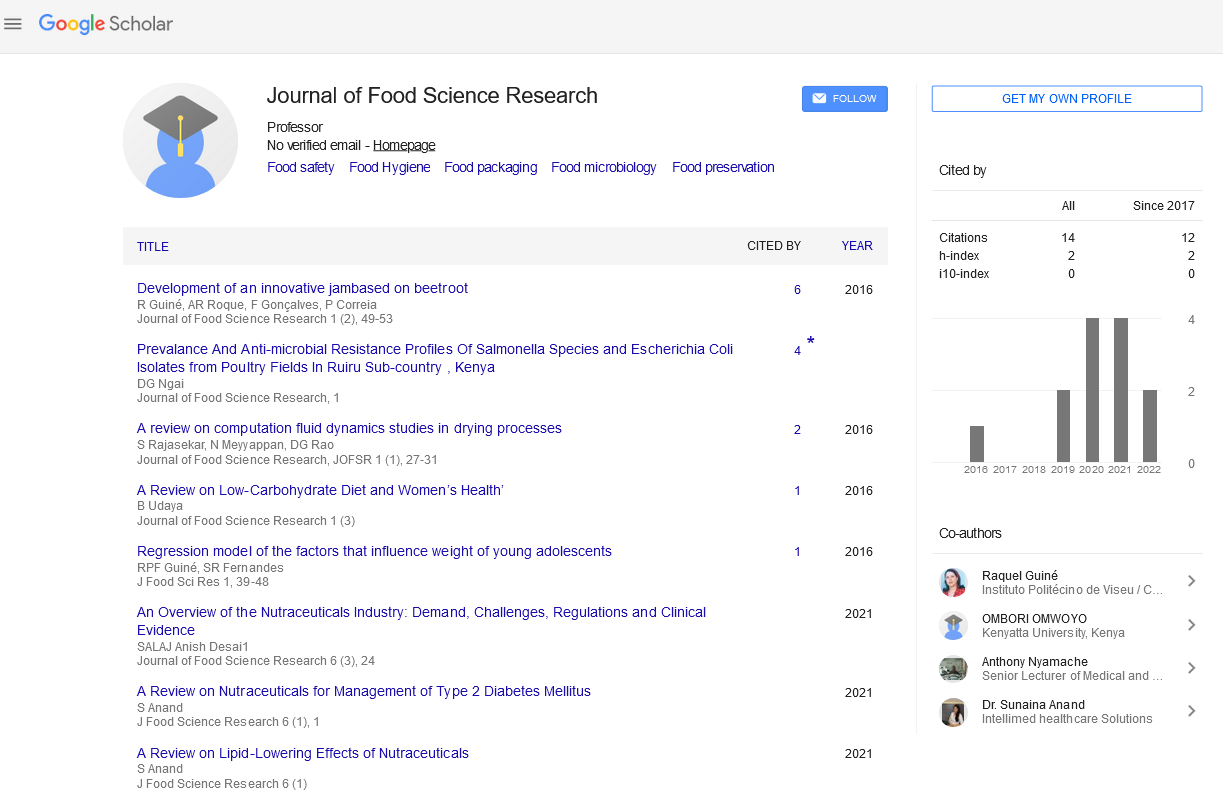Short commentary
, Volume: 7( 1) DOI: 10.37532/. J Food Sci Res.2022.07.93An Analysis of Socioeconomic Determinants of Dietary Habits in LowIncome and Middle-Income Countries
Andrea Silvia*
Department of Food Engineering and Process Management, University of Life Sciences, Warszawa, Poland
*Corresponding Author:Andrea Silvia
Department of Food Engineering and Process Management, University of Life Sciences, Warszawa, Poland
Email: Andreasilvia32@gmail.com
Received date: January 28, 2022, Manuscript No. TSFSR-21-59726; Editor assigned date: January 31, 2022, Pre QC No. TSFSR-21-59726(PQ); Reviewed date: February 10, 2022, QC No. TSFSR-21-59726; Revised date: February 21, 2022, Manuscript No: TSFSR-21-59726(R); Published date: February 28, 2022, DOI: 10.37532/. J Food Sci Res.2022.07.93.
Citation: Silvia A. An Analysis of Socioeconomic Determinants of Dietary Habits in Low-Income and Middle-Income Countries. J Food Sci Res. 7(1):93 @ copy; 2022 Trade Science Inc.
Abstract
Introduction
Among both high-income and low- and middle-income countries, Socio Economic Status (SES) is a significant factor of health (LMICs). One of the processes that explain social inequalities in health is a higher-SES individual?s healthier diet. Indeed, high-SES people in HICs are more likely to eat nutritious foods including whole grains, lean meats, fish, low-fat dairy products, fruits and vegetables, whereas low-SES people eat more fat and less fiber. Only a few researches have established the social patterning of nutrition in LMICs, in contrast to HICs. Although many LowIncome Countries (LICs) still have huge populations living in poverty and suffering from malnutrition, socioeconomic progress is frequently accompanied with a nutrition transition characterized by a move from traditional fibre and grain-richdiets to fat and sugar-rich diets. This transition may begin in metropolitan regions, where refined grains, fats, animal products, sugar, processed foods, and foods eaten away from home are consumed at higher rates than in rural areas.
Furthermore, high-SES individuals are disproportionately affected by the nutrition shift, which is consistent with a higher prevalence of obesity in high-SES individuals in LMICs. However, as the nutrition shift progresses, the social patterning of a diet may reverse. When studies on obesity suggested, people of low socioeconomic status tend to adopt unhealthier diets as their socioeconomic status improves. Non Communicable Disease (NCD) deaths already account for four out of every five deaths in LMICs, and the NCD burden in these nations is likely to climb in the coming decades. High intakes of salt, saturated fats, and sugar, as well as poor intakes of fruit, vegetables, and whole grains, arethought to be key risk factors for the development of NCDs. As a result, promoting a healthy diet at the population level is both a priority for NCD prevention and control, as well as a source of worry when it comes to social inequalitiesin NCDs. If sufficient preventative strategies are to be created, an understanding of the determinants of food patterns in LMICs is critical.
Energy and Nutrients
Future food environment research should focus on low- and lower-middle-income countries, as well as a wide range of dietary, nutrition, and health outcomes. Improving the quality of food environment research is essential for developing viable, suitable, and effective interventions to promote public health nutrition in LMICs. There was no evident pattern in the relationship between SES and calorie intake. In general, people with a higher socioeconomic status consumed more energy, owing to easier access to low-cost energy-dense foods and higher-cost, higher-quality foods. However, the findings were mixed, with some research reporting decreased calorie intake in people with a high socioeconomic status. Lower energy intakes in high-SES individuals in Brazil could be linked to the general decrease in carbohydrate intake and increase in fat and protein intake that has been observed since the 1960s. Brazil?s nutrition shift may be further along than in other countries, with unhealthy food patterns already more prevalent among low-SES groups. Energy consumption was also higher in cities, which contributed to the higher prevalence of overweight and obesity in LMIC cities. Higher protein intake was substantially related with higher SES and urban location, reflecting the increased intake of animal items that accompanied the dietary change. Because only research from MICs looked at protein intake, no clear conclusions about the SES-protein relationship in LMICs could be formed.
Individuals with a higher socioeconomic status and those who live in cities consumed fewer carbohydrates. This pattern was particularly noticeable in Latin America, and it could be attributed to high-SES persons? increased use of processed foods (which replaced traditional carbohydrate-rich diets). Urban and rural people consume different types of carbohydrates, with urban residents consuming more refined grains (rice or wheat), which are more frequently supplemented with vitamins and nutrients in MICs than LICs. Individuals with a higher socioeconomic status and those who live in cities ingested more fat (total fat, SFA, MUFA, and PUFA). This result was unsurprising, given that a high-fat diet has been linked to increasing affluence and retail development. In wealthy people, a high fat consumption may be due to a higher diet of animal-source meals. In Mexico, people with a high socioeconomic status and those who live in cities increased their intake of SFA and protein. However, in certain countries, such as China, domestic production and imports of vegetable oils grew during the early stages of the dietary shift. As a result, unsaturated oil consumption grew higher than saturated fat consumption from imported meat and dairy products in the general population. Individuals with a higher socioeconomic status and those who live in cities ingested less fiber. Between 1969 and 1986, there was a general reduction in fiber intake throughout Central America, according to one study. Changes in consumption patterns as a result of more people working outside the home contributed to this decline, which was particularly evident for high-SES individuals.
Higher fiber consumption in low-SES individuals in Mexico could be attributed to increase eating of traditional fiber-rich foods (e.g., tortillas). Despite the fact that people with a higher socioeconomic status ate more fruits and vegetables, the population?s overall intake was low by worldwide standards. In developing economies, a westernization of diet prompted by globalization provides both an opportunity to consume more healthful and diversified meals as well as an opportunity to consume more low-cost, energy-dense foods. High SES or urban individuals in MICs had greater vitamin and micronutrient intakes, similar to HICs, owing to a larger consumption of animal proteins (source of vitamin B-12 and iron) as well as fruits and vegetables (sources of vitamin C, iron, and potassium). More research into the relationship between SES and vitamin intake in LICs is needed. A high SES and urban location were related with improved dietary quality, diversity, and healthier patterns regardless of a country?s GDP, as evidenced in HICs. Among LICs, however, more dietary diversity was associated with higher animal-food intake in high-SES groups. Many rural residents in many LICs, and even some MICs, still lack access to electricity and rely on unsafe food preservation techniques (salt and smoked foods). They also have restricted access to imported foods, which may contain additional sodium, sugar, or trans-fat but bring diversity to their diet. In recent years, the price of staple foods has risen dramatically over the world, forcing millions of people in LMICs into poverty. Increased prices lowered remittances, which are a major source of income in LMICs, and reduced dietary diversity among low-income people. Higher dietary diversity, on the other hand, does not always suggest that nutrient requirements are met, and it is sometimes linked to higher consumption of harmful foods like frying oil and sweetened items. In several MICs, people with higher SES ate unhealthier diets than those with lower SES (e.g., higher intakes of saturated fat, sugar, and energy-dense foods). Inadequate nutrient intake was shown to be common across all socio economic categories in a Brazilian national dietary survey (although it was higher in low-SES groups).
This finding supports the theory that the nutrition transition, which is linked to a country?s economic development, trade liberalization, global advertising, and fast-food consumption, has the greatest impact on those of high socioeconomic status. According to the diffusion of innovation hypothesis, these lifestyle modifications inevitably spread to other social strata throughout time. Our findings suggested that in LMICs, social inequalities in dietary intake exist, with those with low SES or who live in rural regions having a reduced dietary diversity and lower intakes of key nutrients. In HICs, lower-SES persons? unhealthier dietary choices may be explained by a number of variables, including the greater expense of better diets, the lack of nutritious foods in low-SES neighborhoods, and a weaker responsiveness to nutrition-prevention messages. Although mechanisms underlying social patterning of nutrition in LMICs are still being researched, policies aimed atpreventing and controlling NCDs in LMICs should address these critical features by enhancing food diversity, avail- ability, and affordability for low-SES groups and the rural population. Government actions to ensure that selected healthy foods remain available at reasonable prices, subsidization of fruit and vegetables, support of local food production, empowerment of women to achieve food security, investment in communication and transportation infrastructures in rural areas, and food industry reformulation of manufactured foods are all examples of interventions that could potentially improve diet quality and diversity in low-SES and rural people. In certain studies in LMICs, cash transfers to disadvantaged communities have been proven to improve fruit and vegetable consumption as well as nutritional diversity

